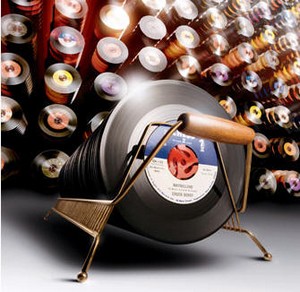
American Bandstand was an American musical variety show that aired in various versions from 1952 to 1989, hosted from 1957 until its final season by Dick Clark, who also served as producer. The show featured teenagers dancing to Top 40-type music introduced by Clark; at least one popular musical act—over the decades, running the gamut from Jerry Lee Lewis to Run DMC—would usually appear in-person to lip-sync one of their latest singles.
The Corny Collins Show is a fairly direct parody of American Bandstand and The Buddy Deane Show. The Buddy Deane Show was a teenage dance music show that ran in Baltimore from 1957-1964, and was taken off the air because the local station WJZ could not integrate black and white dancers.

Winston "Buddy" Deane was a broadcaster for more than fifty years, beginning his career in Little Rock, Arkansas, then moving to the Memphis, Tennessee market before moving onto Baltimore where he worked at WITH-AM radio. He was one of the first disc jockeys in the area to regularly feature rock-and-roll. His dance party television show debuted in 1957 and was, for a time, the most popular local show in the United States. It aired for two and a half hours a day, six days a week.
The core group of teenagers who appeared on the show every day were known as the "Committee." These kids developed a huge following of fans and hangers-on in Baltimore who emulated their dance moves, followed their life stories, and copied their look. Several marriages resulted from liaisons between Committee Members. In fact, the blog http://bdcommittee.blogspot.com/ is an active site for Committee Members to stay in touch.
Many top acts of the day, both black and white, appeared on the show. Acts that appeared on The Buddy Deane Show first were reportedly barred from appearing on Dick Clark's American Bandstand. If they were on Bandstand first, however, they could still be on The Buddy Deane Show. Although WJZ-TV, owned by Westinghouse Broadcasting (now CBS), was an ABC affiliate, the station "blacked out" the network broadcast of American Bandstand in Baltimore and broadcast the Deane program instead, reportedly because Bandstand showed black teenagers dancing on the show (although black and white teenagers were not allowed to dance together). The Deane program set aside every other Friday when the show featured only black teenagers (the rest of the time, the show's participants were all white).
The racial integration of a take-off of the show, dubbed the The Corny Collins Show, provides the backdrop to the 1988 John Waters movie Hairspray starring Divine and Ricki Lake, the Broadway musical Hairspray starring Harvey Fierstein and Marissa Jaret Winokur, and the 2007 movie Hairspray featuring John Travolta and Nikki Blonsky. Although he never appeared on Deane's show himself, Waters attended high school with a "Buddy Deaner." HAIRSPRAY makes one significant departure from the real show: Mr. Deane's show was not successfully integrated after a stirring civil-rights struggle. Unlike the hard-line segregationists depicted in the show, WJZ-TV's managers wanted the show to integrate. But white Baltimore wasn't ready. "The management of the station did not realize that Baltimore was very much a Southern-oriented city," Mr. Deane said in a 2002 interview with The Associated Press. He said they "asked each member of the show's committee of regular dancers what they thought about integration, and they said, 'Well, it's O.K. with me, but my folks won't be happy.' That was the general consensus."
The video linked here is the original "Madison" on the Buddy Deane Show.
SOURCES
http://www.ultimateoldiesradio.com/djpage.cfm?djID=1&name=Buddy+Deane
http://en.wikipedia.org/wiki/Buddy_Deane_Show
http://en.wikipedia.org/wiki/American_Bandstand
http://bdcommittee.blogspot.com/
http://www.nytimes.com/2003/07/27/nyregion/buddy-deane-78-tv-host-and-inspiration-of-hairspray.html


